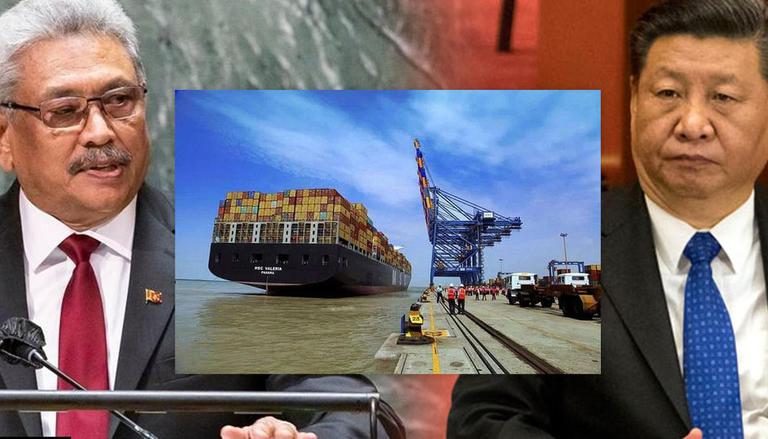
On July 7, 2021, while participating in the centenary celebration of the Communist Party of China, Sri Lankan Prime Minister Mahinda Rajapaksa praised Beijing lavishly for “successfully eradicating” poverty of 900 million people in China and helping the other countries in achieving their economic growth. He had also expressed his confidence that China would “bring back the economic strength that Asia had 500 years ago through the Silk Road.”
Today, this rhetoric has lost meaning for none other than Sri Lanka itself as China, the so-called Middle Kingdom, which was effusively praised by the island country’s Prime Minister during the CPC’s centenary celebration, is seen as a major culprit behind Colombo’s struggle for survival.
Burdened by $ 35 billion foreign debt, which has a fair share of China’s loans, the island country is deep under unfathomable crisis with merely US $ 1.5 billion in its foreign reserve to make payment for imports.
In 2022, the island country has to pay more than US $ 7 billion in repayments on debts and of which, according to Fitch Ratings, US $ 3 billion has to be paid during the first quarter of the current year. It has just paid US $ 500 million due on a sovereign bond. In July, it will make a repayment of US $ 1 billion for another bond.
China, which has lent billions of dollars to Sri Lanka, partly under its ambitious Belt and Road Initiative, for infrastructure projects, including highways, ports, airport and a thermal power station, is a major contributor to Sri Lanka’s mounting debt. More than US $ 2 billion have to be paid to China in 2022.
There is a fear that Sri Lanka, badly mauled by the deadly pandemic, may default on further repayments. However, if it decides to move ahead on the repayment of foreign debts, the country, in deep frustration on account of a huge rise in prices of fuel and edible items, will see possible food riots. This has been warned by several experts and economists in the country. “Available foreign currency reserves must be used to meet essential needs, not to repay foreign debts,” Anila Dias Bandaranaike, a former Assistant Government at the Central Bank of Sri Lanka recently warned.
In the history of Sri Lanka, there have been several ups and downs–economically and politically. But this is the first time in decades, the island country is in the midst of the worst financial crisis—all this, due to the mismanagement of economy, constant commercial borrowings at high costs from international capital markets to fund infra projects, accumulating repayments to international sovereign bonds, institutional bonds and others.
International sovereign bonds alone account for 36.4 per cent of the country’s external debts and of this, China’s share stands at 10.8 percent (US $ 3.5 billion). Apart from this, China has lent billions of dollars to Sri Lanka for its infrastructure projects. Under its Belt and Road Initiative, China has provided more than US $ 5 billion for projects including roads, airports and ports. Besides, China has also been a major contributor to Sri Lanka’s foreign borrowings. From 2008 to 2021, approximately 70 percent of foreign borrowings have come to Sri Lanka from China. And, Sri Lanka has borrowed money from China at an exorbitant interest rate: 6.5 percent per annum.
Ironically, the island country has used all this Chinese money to finance more than 50 projects and of which, majority has turned out to be non-significant or unnecessary ones in terms of money spent on them. For example, Mattala Airport built by using commercial loans from China still remains empty as it is not frequented by any airlines; Hambantota International Stadium built in a similar manner with Chinese money is lying useless; ships do not make any call at the Hambantota Port.
Moreover, despite huge protests from the civil society members and politicians, the Rajapaksa government has decided to go ahead with China-backed US $ 1.4 billion Colombo Port City. There is an apprehension among local Sinhalese population that like Hambantota Port which was leased to China for 99 years in return for US $ 1.1 billion loans Sri Lanka took from Beijing to build the project, the island country will also lease Colombo Port City to China in return for loans taken to build the project. However, before it could be announced officially, people started calling Colombo Port City as ‘Chinese colony’ in Sri Lanka.
For the moment, Sri Lanka’s state of affairs is passing through uncertainty and chaos. Consumer price in December 2021 shot up a record 14 per cent, surpassing a previous high of 11.1 per cent recorded in November. In Asia, this is seen as the first highest inflation after Pakistan’s 12.3 per cent. But while Pakistan, also under huge debt due to loans from China and other countries, is on the verge of bankruptcy, whether Sri Lanka will ever be able to avert deepening financial and humanitarian crises is a big question. During the recent visit of Chinese Foreign Minister Wang Yi, Sri Lanka requested China to restructure its debt repayments.
China, which is facing international criticism for Sri Lanka’s on-going worst financial crisis, reportedly ignored the island country’s request. However, India being a close neighbour of Sri Lanka, didn’t like the island country to carry the cross of sufferings any more. It extended US $ 400 million to Colombo under the SAARC currency swap arrangement and deferred ACU settlement of US $ 515 million by two months. It also extended a credit facility of US $ 1 billion for purchasing food and essential items and medicine and US $ 500 million for buying fuel. Yet the dominant question lying uppermost in every international watcher’s mind is: Will Sri Lanka ever get out of debt-trap?
-The writer is a senior journalist with abiding interest in foreign affairs and diplomacy. The views expressed are personal and do not necessarily carry the views of Raksha Anirveda.








